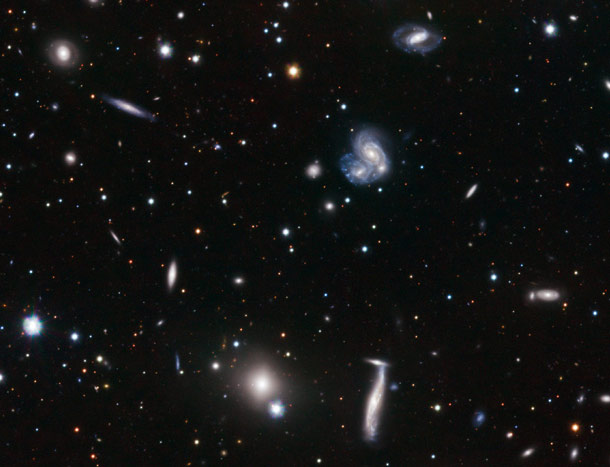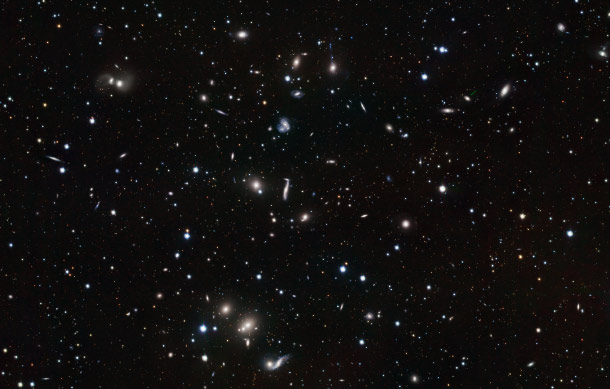Labors of the Hercules Cluster

We live in the Milky Way galaxy, a collection of more than a hundred billion stars forming a flat, spiral disk. Our galaxy is in turn part of a small group called the Local Group, just a few dozen members strong, of which we are among the largest. But galaxies live in larger groups yet, called clusters. Some have hundreds of galaxies, and some thousands. In the direction of the constellation of Hercules is one such smaller cluster, called (duh) the Hercules Cluster, just under 500 million light years from Earth. The VLT Survey Telescope took a look at the cluster and produced this spectacular picture of it:
[Click to galactinate, and you want to; I reduced the size considerably to fit it here.]
The cluster is unusually rich in spiral galaxies, and unlike bigger groups doesn't have one, massive galaxy sitting at its core (the result of a bigger galaxy falling to the center and eating lots of other galaxies, growing huge in the process). Still, the small size of the cluster means a lot of its members are interacting, and if you look closely you see lots of them tugging at the others:

That edge-on spiral in the lower right is clearly warped, so I expect it's suffered a near miss from another galaxy in the past few million years (maybe that little spiral above it, or more likely the severely messed-up fuzzball to the left), and other examples aren't hard to find.
As an aside, when I was poking around the big image I saw lots of red dots aligned next to green ones on the left near the bottom, and realized that must be an asteroid, captured as it moved slowly across the field of view in the multiple exposures and different filters used to make this picture. A long green streak below that may be another asteroid moving much rapidly, or possibly a satellite that streaked across one exposure.
Take a look for yourself. What do you see?
And a thought for you: This small cluster is part of a larger complex called the Hercules supercluster, made up of many smaller groups like the Hercules cluster. Altogether, the supercluster is something like 300 million light years across... and is still not the largest structure. Hercules, together with the Coma Cluster and Leo Cluster, comprise what's called the Great Wall: a vast structure that is among the largest in the Universe -- it's so big that even at its distance of several hundred million light years away it spreads across more than one-third of the visible sky!
Thinking about these types of things can numb the mind... but remember, the most amazing thing to me about all of this is that we can know them at all. We're a part of all this, and when we look out at it, when we examine it, we are learning about ourselves. I think peering out into the cosmos so that we can better understand ourselves is one of the noblest things we humans can do, and using science as our tool the best way to do it.
And look what's it's given us! The entire Universe! We cannot possibly ask for anything more.
Credit: ESO/INAF-VST/OmegaCAM. Acknowledgement: OmegaCen/Astro-WISE/Kapteyn Institute
Related Posts:
- Slip into the Coma
- The face of beauty
- Galaxy on the edge of space
- Cluster tucked at the far reaches of the Universe





























